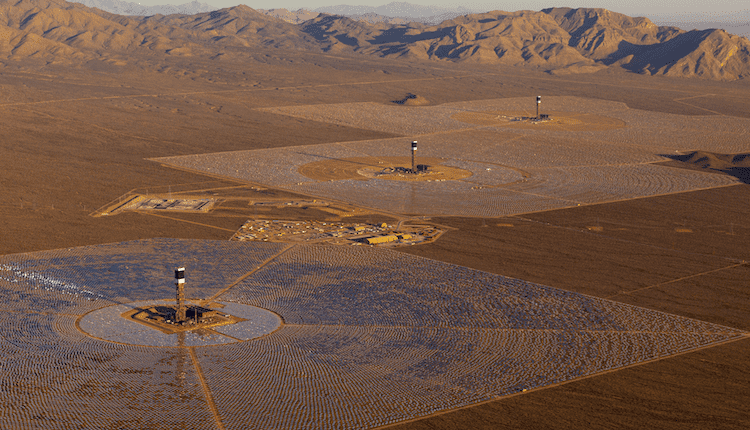Introduction to Solar
Another renewable energy source is solar power. Solar technologies are responsible for converting solar radiation (sunlight) into heat or electrical energy, that then produces electricity. According to the U.S. Department of Energy, “there are two main types of solar energy technologies—photovoltaics and concentrating solar power.” With photovoltaics (PV), the electrical energy produced within the panels allows electricity to generate and flow (Source). These panels are the type of solar system you may have seen on the roof of a neighbor’s home or a local business. In concentrating solar power (CSP) systems, heat from solar radiation is used to produce electricity. The photo shown below is an example of a power tower CSP system. In this particular power plant, a large number of flat, sun-tracking mirrors, known as heliostats, focus sunlight onto a water-filled boiler atop each of three tall towers. When the sunlight hits the boilers, the water inside is heated and creates high temperature steam. The steam is then piped to conventional steam turbines, which generate electricity.1US Department of Energy. (n.d.). Ivanpah. Energy.gov. Retrieved January 24, 2022, from https://www.energy.gov/lpo/ivanpah

Concerns Related to Solar, Mined Materials and Energy Storage
Solar concerns
Solar is also a widely touted renewable energy source due to its ability to reduce the cost of electricity, create new jobs reliant on clean energy, and contribute to the grid. While solar is a clean energy source, there are some disadvantages to its use. The most significant setback being that the sun doesn’t always shine where the PV panels or CSP systems are placed. However, if we have sufficient battery availability, we can store some of this energy that is produced when the sun is shining for backup power once the sun goes down. Environmentalists are concerned about harm to birds (burned in flight) and desert habitat with CSP systems. A number of minerals that play an important role in solar cells are only available outside of the United States—making us 100% reliant on foreign sources for these materials.2Office of Energy Efficiency and Renewable Energy. (n.d.). How does solar work? Energy.gov. Retrieved January 24, 2022, from https://www.energy.gov/eere/solar/how-does-solar-work This concern is further discussed below.
Critical mineral concerns related to the energy transition
Wind turbines, solar panels and improved energy storage (i.e., batteries) all require significant elements, such as copper, nickel, cobalt and lithium, as well as rare earth elements. These various materials will be extracted from the earth through the mining industry. You may also hear some of these minerals referred to as critical minerals, as they are considered crucial by the U.S. government to make America’s economy and defense more secure.

As an example of a mineral that is critical to the renewable energy infrastructure, let’s consider the use of cobalt. The Democratic Republic of Congo supplies more than two-thirds of the world’s cobalt. The largest use of cobalt is in portable consumer electronics like cell phones, laptop computers, and tablets, which are all powered by lithium-ion batteries. Cobalt is also found in the lithium-ion batteries used in many electric vehicles.3Fresh Energy. (2022, January 5). What’s up with the cobalt used in EV batteries? Fresh Energy. Retrieved January 24, 2022, from https://fresh-energy.org/whats-up-with-the-cobalt-used-in-ev-batteries
In countries struggling with political instability, such as the Democratic Republic of the Congo, mineral extraction can be linked to violence, conflict and human rights abuses. Cases of child labour, exploitation and fatal accidents have been linked to a lack of oversight by the Congolese government.4Ocamringa, C. (2021, November 5). Human rights violations on the rise in Democratic Republic of Congo. Newsy. Retrieved January 24, 2022, from https://www.newsy.com/stories/human-rights-violations-in-congo-s-cobalt-mines/ As a result of these concerns related to cobalt mining, electric vehicle manufacturers are working to transition away from cobalt (e.g., Tesla and GM).5Fresh Energy. (2022, January 5). What’s up with the cobalt used in EV batteries? Fresh Energy. Retrieved January 24, 2022, from https://fresh-energy.org/whats-up-with-the-cobalt-used-in-ev-batteries
Another set of critical minerals needed for renewable infrastructure is also in the headlines quite a bit—rare earth elements. The group is made up of a set of 17 nearly-indistinguishable lustrous silvery-white soft heavy metals with diverse applications in electrical and electronic components, lasers, glass, magnetic materials, and industrial processes. They are called ‘rare’ not because they rarely exist in the earth, but because they are not typically well concentrated in the rock (ore) that could be mined for extraction. Thus it is ‘rare’ to find an economically exploitable ore deposit.

Clean energy technologies, such as large wind turbines and electric vehicles, use permanent magnets that usually contain four rare earth elements: praseodymium (Pr), neodymium (Nd), samarium (Sm), and dysprosium (Dy). Why? Rare-earth magnets are stronger per unit weight and volume than any other magnet type.6USGS. (n.d.). The Rare-Earth Elements – Vital to Modern Technologies and Lifestyles. Retrieved January 24, 2022, from https://pubs.usgs.gov/fs/2014/3078/pdf/fs2014-3078.pdf Even so, a 3-MW wind turbine contains close to 2 tons of rare earth permanent magnets. Each motor in an EV contains around 1-2 kg of magnets.
Demand for rare earths is expected to rise sharply in the coming years in response to the growth in wind turbine installations and electric vehicle adoption. Based on the sustainable development scenario from the International Energy Agency, demand for neodymium (Nd) alone in low-carbon power generation and EVs could climb by more than 600% from 4,900 tons in 2020 to 37,700 tons in 2040.7Rodriguez, L. (2021, September 23). Rare metals in the photovoltaic industry. RatedPower. Retrieved January 24, 2022, from https://ratedpower.com/blog/rare-metals-photovoltaic/
Supply concerns
The demand for rare earth elements saw its first explosion in the mid-1960s, as the first color television sets were entering the market and europium (Eu) was the essential material for producing the color images. The United States once was largely self-sufficient in these critical materials, but over the past decade has become dependent upon imports.8USGS. (n.d.). Rare Earth Elements: Critical Resources for High Technology. USGS Fact Sheet 087-02. Retrieved January 24, 2022, from https://pubs.usgs.gov/fs/2002/fs087-02/ A concern in the United States about our use and future need of rare earth metals is that China provides more than 85% of the world’s rare earth metals today. The United States is concerned that any disruption to American supply chains for such products would hurt key industries.9Nyabiage, J. (2021, April 26). China’s dominance of rare earths supply is a concern in the West. South China Morning Post. Retrieved January 24, 2022, from https://www.scmp.com/news/china/diplomacy/article/3130990/chinas-dominance-rare-earths-supply-growing-concern-west
Batteries
As concerns for energy independence, climate change, and other issues drive the sale of electric and hybrid vehicles, the demand for batteries made with rare earth compounds will climb even faster. Based on the sustainable development scenario from the International Energy Agency, demand for neodymium (Nd) alone in low-carbon power generation and EVs could climb by more than 600% from 4,900 tons in 2020 to 37,700 tons in 2040.10Rodriguez, L. (2021, September 23). Rare metals in the photovoltaic industry. RatedPower. Retrieved January 24, 2022, from https://ratedpower.com/blog/rare-metals-photovoltaic/
Renewables Filling the Power Gap
We have already looked at filling the gap with renewables by solely using wind power. Let’s now look at how we might fill the power gap by examining the capability of solar energy. As a reminder, we can look at the table below and remind ourselves that the gap is 14.4 quads.
2020 Energy Consumption (Quads) Compared to a Potential 2040 Scenario11 https://www.eia.gov/energyexplained/us-energy-facts/, Energy Information Agency (EIA). U.S. Energy Information Administration, Monthly Energy Review, Table 1.3 and 10.1, April 2021, preliminary data. Accessed: 11/22/2021.
| Fuel | 2020* | 2040 | Change |
|---|---|---|---|
| Petroleum | 32.2 | 10.3 | -21.9 |
| Natural Gas | 31.5 | 34.5 | 3 |
| Coal | 9.2 | 9.2 | 0 |
| Nuclear | 8.2 | 8.2 | 0 |
| Hydro-electric | 2.5 | 2.5 | 0 |
| Renewables | 9.1 | 13.6 | 4.5 |
| Total | 92.7** | 78.3 | -14.4 |
U.S. energy consumption by source in 2020, with a potential scenario for 2040. Energy measured in quadrillion BTUs (quads). *Actual numbers reported by EIA may differ between publications as reports of actual consumption are updated. For this study please refer to the April 2021 EIA data. ** Sum of components on EIA publications may vary slightly due to independent rounding.
We looked at this pie chart previously to see that wind and solar comprise 26% and 11% respectively of our 11.6 quads of renewable energy consumption. Let’s focus in on filling the gap by bumping up our solar energy use.

Could Solar Alone Fill the Gap?
While solar power is more affordable and accessible than it ever has been, the current solar power in the United States provides 1.3 quads of energy according to our data. To fill the 14.4-quad gap, we would need to increase solar by ~1,100%. This enormous growth seems unrealistic. However, if we were to address barriers to adopting solar power technologies, we could depend on solar to supply a lot more of our electrical demand in the future. Astral Energy published an article that points out five significant barriers to solar energy technologies including market entry, capital costs of building the technologies, misconceptions regarding their reliability, siting and transmission (this includes where to put the solar technologies along with ensuring there are transmission lines equipped and nearby to transport the power), and the fact that there is an uneven playing field in comparison with other multi-billion dollar energy industries.12Afox. (2020, December 15). 5 barriers towards Renewable Energy Technologies. Astral Energy. Retrieved January 24, 2022, from https://www.astralenergyllc.com/5-barriers-towards-renewable-energy-technologies/
Fun Fact: Solar Panels Powering the World
According to Axion Power, it would take 51.4 Billion 350W (watt) solar panels to power the world. This many solar panels congregated into a singular solar plant would cover 115,625 square miles, or 74.16 million acres. For comparison, Arizona, one of the ten largest states, is the size of 113,642 square miles. Additionally, if we decided to cover the 11 smallest states in the United States we’d still fall short! Now let’s think about what it takes to just power the United States with solar panels. That would require 10 Billion 350-W solar panels, enough to cover a surface area of 21,913 square miles. Do you think this is possible? Maybe, but solar and battery capacity must become more efficient to do so. Axion Power notes, “although less fun, it’s more useful to consider whether each country or region could put together a massive solar planet.”13Aaron. (2020, September 17). Powering the entire world with solar: Surface area and panel requirements. Axion Power. Retrieved January 24, 2022, from https://www.axionpower.com/knowledge/power-world-with-solar/
Image Credits
- DOE-LPO_Project-Photos_CSP_Ivanpah_06: BrightSource Energy
- Cobalt Ore: USGS
- Rear Earth Elements: USGS